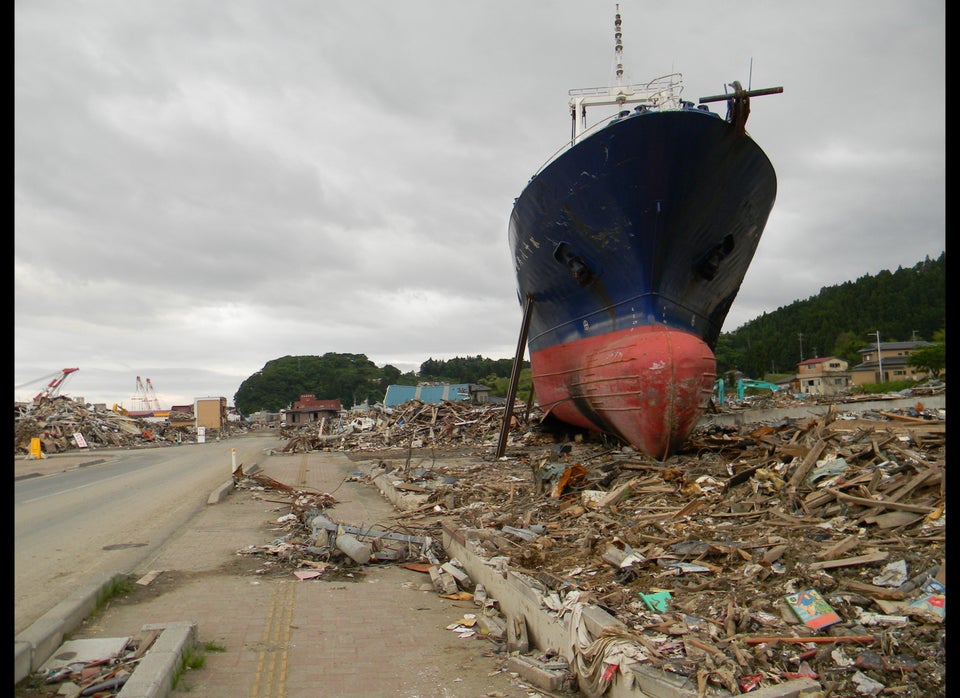In the Journal of Glaciology, research suggests that the Japan's 9.0 earthquake and tsunami combo in March 2011 coerced a piece of ice about twice the size of Manhattan to break free from its Antarctic home.
June 28, 2011
The ride from Tokyo is uneventful. We take the bullet train from Tokyo Station up the western corridor, running through Fukushima and up to Miyagi Prefecture. The countryside so far seems untouched by the earthquake -- there are no buildings cracked in two, no fissures in the concrete. And the tsunami didn't reach this far, so the summer landscape is verdant. The rice paddies are submerged in water, with rows of green stalks emerging from the shallow pools.
But when we receive the announcement that we're about to arrive at Fukushima station, I momentarily panic. Sandie asks if I still have those potassium iodide pills, and I reach into my bag and distribute them to the four of us, but Stephen waves my offer away. It's bad for solidarity, I know. One gulp, and the pill is gone, along with any worries about radiation absorption. But then I begin to worry about the potassium iodide. What are the side effects? I couldn't remember, and was kicking myself for being so stupid to think that a pill can medicate against times like these.
At this point, the train stops at Fukushima and the doors open. A few people get off the train. In my head, I chide myself for being a baby, but I keep imagining an invisible radiation cloud rolling in through the doors before they close. Because we're in Japan, I imagine the cloud to be a little bit cute. I know it's wrong, but that's what I'm thinking. When I try to snap a photo of the sign written in hiragana, I realize I can't because the train is now picking up speed; we whoosh past green markers telling us that we are in a place now known for a nuclear reactor gone awry. In the Japan Times today, an article listed forty Olympic-size swimming pools of toxic water at Fukushimi Daichi plant that were in imminent danger of leaking into the Pacific.
An hour later we are in Miyagi Prefecture; we exit the station and then see the tour bus that is waiting for us outside. It is clean and white, with a wacky hexagonal print of pink, green and yellow pastels. For the next three days, this giant gas-guzzler will be our sole method of transportation on a tour of the Tohoku disaster zone.
A few moments after we arrive at the port in Kesennuma, an identical tour bus pulls up perpendicular to ours. A white man in a nice suit emerges, wearing hip black sunglasses and shiny dress shoes. More follow, and then a striking blond woman with Tilda Swinton hair exits the bus. The Swedes have arrived. I'm not sure if they're on a diplomatic mission or just on a tour of the disaster zone, but we nod at each other and then walk in separate directions.
The first thing you notice is the smell of rotten tatami mats. Upended, lying supine, in stacks on the fetid ground, these mats are in various places along our walk. Shards of wood are strewn about. It reminds me of Katrina. In "Goodbye to All That," John Jerimiah Sullivan writes this about New Orleans: "It looked contrary to the laws of physics, to the point where you saw it in miniature, a toy box overturned by an angry child."
Northern Japan looks the same, with ships cast ashore and left there, and houses that exist in name only. At Lawson's, a popular convenience store that now has a temporary location at the top of a very tall hill, you can look down and see the destruction below. Mr. Kino, the general manager, greets us outdoors. He wears a chartreuse striped dress shirt under a garish blue and white striped work shirt with a bright pink zipper. His hands are folded in front of him, with fingers interlaced, and he squints in the sunshine as he rattles off the number of Lawson stores that were closed because of the tsunami (21), the number in Kesennuma (six) and the date a new store will open in the area (mid-July).
It starts to rain, and Mr. Kino keeps talking, giving absolutely no indication that he recognizes the massive drops of rain falling on us from an erupting sky. We discover that the Lawson higher ups conducted a poll of townspeople to see what items they needed the most in the days following the tsunami. The response: slippers, earplugs, hangers, rice bowls, chopsticks and mirrors. Say what you will, but even people in disaster areas deserve to be a little vain.
In the store now: razors, porno mags, hair gel, men's Bioré, mini (or Japanese-size) containers of Haagen-Dazs ice cream in various flavors, potato chips, Power Rangers children's picture books. Oh. And Calorie Mate. Dozens of the signature yellow packets line the left side of the racks. I was later informed by a friend that it's not for dieting, though the packaging suggests otherwise. But kanten, agar jelly, is in great supply here, and there's no way anyone can convince me that people eat that for any other reason than because it helps you shed some weight. That stuff is terrible.
So what am I doing here, exactly? There is still something to be said for bearing witness, though I don't feel all that useful as I walk through the rubble of other people's homes and prized possessions. The guys at the State Department in Tokyo told us that "Japan is back in business," and it might be that way for the capital city, but up north all I'm seeing is destruction.
